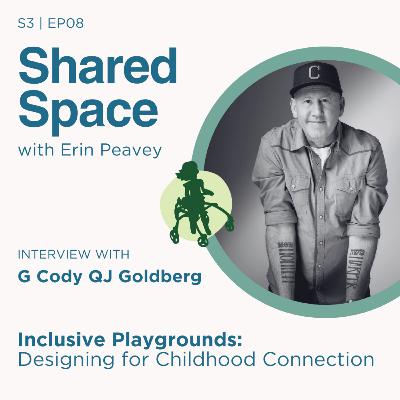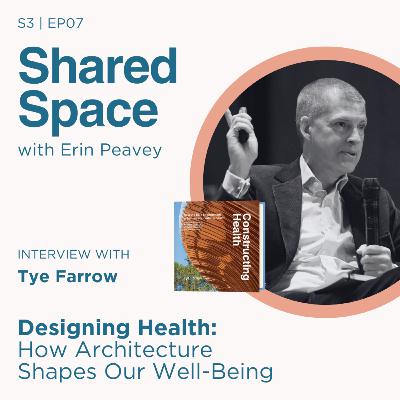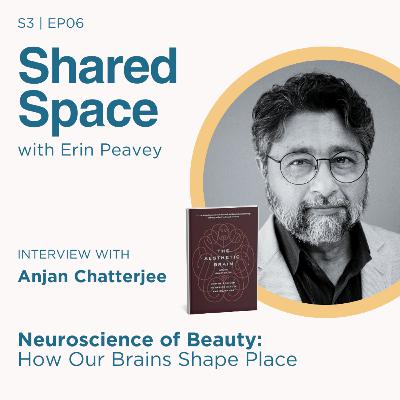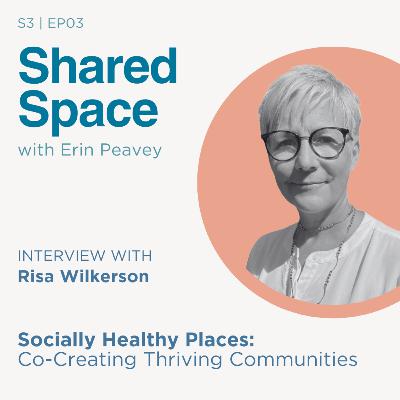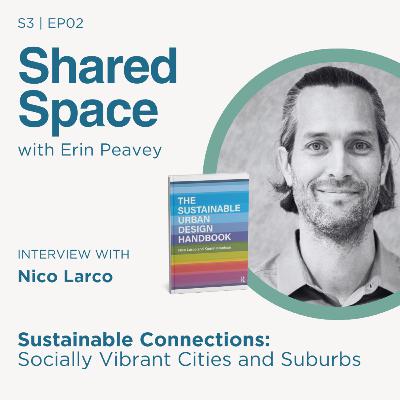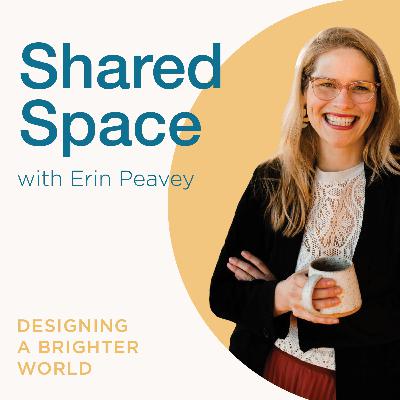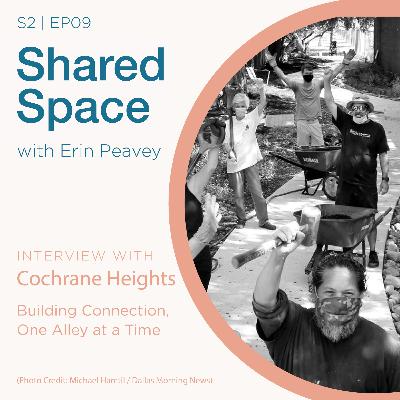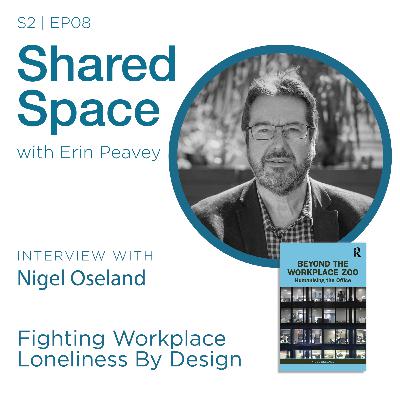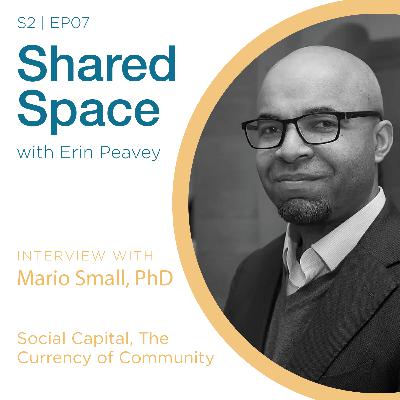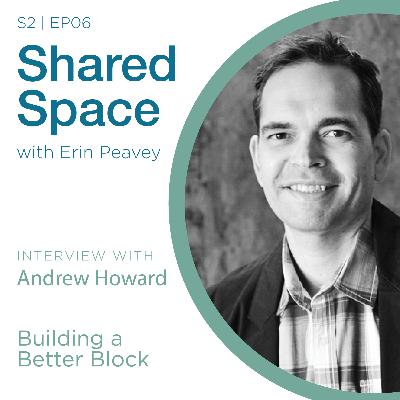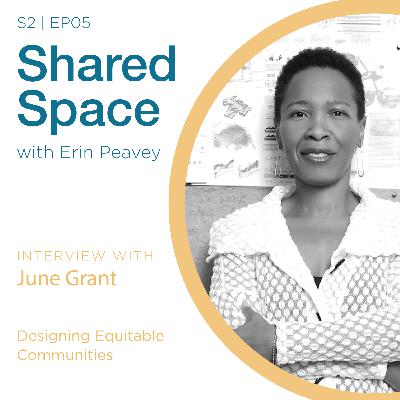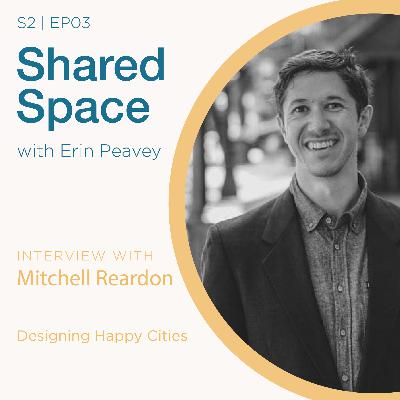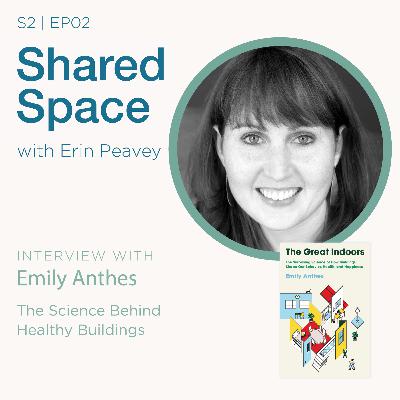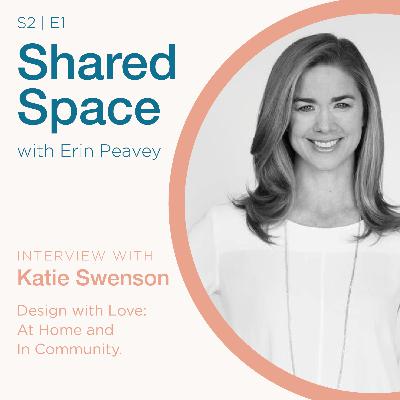Discover Shared Space
Shared Space

Shared Space
Author: Erin Peavey
Subscribed: 11Played: 146Subscribe
Share
© Erin Peavey
Description
Host Erin Peavey explores how our lives shape and are shaped by design. Through interviews, science, and storytelling she reveals the hidden power of architecture and design to make us healthier, happier and more connected.
35 Episodes
Reverse
Diana Lind is an author and urban policy specialist whose work is reshaping the way we think about cities, housing, and the future of community. With a passion for creating more inclusive, connected, and sustainable urban environments, Diana is the author of the groundbreaking book Brave New World: Our Future in Smarter, Simpler, Happier Housing, which explores the evolving landscape of housing and the misconceptions of the American Dream.Diana’s career spans multiple influential roles, from writing for renowned publications like The New York Times to speaking on stages about urban policy, design, and the future of cities. Her insights are not just theoretical but rooted in real-world experiences and challenges, and as a frequent speaker, she has earned accolades like the TED City 2.0 Prize and the ACLU Standup for Freedom Award. She is also a visiting fellow at the prestigious Johns Hopkins SNF Agora Institute, where she continues to push the boundaries of urban policy innovation.Raised in Manhattan and now based in Philadelphia with her family, Diana's journey has been shaped by a deep understanding of both urban and suburban life. She has lived and worked in cities across the country, gaining a unique perspective on how spaces can foster connection and community. Diana is a powerful advocate for rethinking zoning laws, housing policies, and the traditional ideals of homeownership that often leave people behind. Through her work, she challenges us to think beyond the status quo and embrace a future where housing is not just a commodity, but a path to shared prosperity.Her writing, including her popular Substack, The New Urban Order, encourages readers to rethink their relationship with the built environment and provides a roadmap for creating cities that work for everyone; regardless of income, race, or background. Diana’s work continues to inspire a new generation of urbanists, architects, and policymakers, urging them to design spaces that are not only functional but deeply human, fostering connection, inclusivity, and a sense of belonging.Through her work, she invites us all to imagine a future where communities thrive not despite their differences, but because of them.Key Takeaways 1. Reimagine the American Dream – The ideal of owning a single-family home is a recent construct, and it’s time to rethink what home and success truly mean. Let’s build a future where our homes reflect community and connection.2. Embrace Housing Diversity – Explore new models like co-living, multi-generational housing, and accessory dwelling units. These options offer flexibility, inclusivity, and affordable living for all, especially in times of housing crises.3. Address Housing Inequities – Housing policies are deeply connected to issues of race, class, and inequality. By recognizing these ingrained barriers, we can work toward a future where everyone has equal access to safe, affordable housing.4. Support Community Wealth – Move beyond traditional homeownership. Consider community land trusts and shared prosperity models that ensure neighborhoods thrive together and build wealth for residents, and not just investors.5. Foster Connection through Design – Our spaces can bring us together. By designing environments that prioritize in-person experiences, we create opportunities for genuine social connection and a stronger sense of belonging.Quotes1. “The American Dream isn’t a fixed idea, it’s something we’ve created over time. It’s time we ask ourselves: What does a real, connected life look like in our homes and communities?”2. “We need to rethink how we live together, not just in terms of housing, but in the spaces that foster true connection - spaces that reflect who we are and where we want to go.”Connect with Diana Instagram - https://www.instagram.com/thenewurbanorder/Linkedin - https://www.linkedin.com/in/dianalind/Website - https://www.dianalind.com/
G Cody QJ Goldberg is a designer and visionary who is redefining what it means to create spaces that connect, inspire, and empower. As the founder of Harper’s Playground (a nonprofit dedicated to building inclusive playgrounds) Cody has devoted his career to creating spaces where all individuals, regardless of their background or abilities, can play, connect, and thrive together.Harper’s Playground was born from Cody's personal journey as a father. His daughter, Harper, faced significant physical challenges after birth, and at the age of four, her first independent steps were met with the frustration of being unable to navigate the traditional playground in their neighborhood. This moment of powerlessness sparked a lifelong mission to create spaces that are truly accessible to all. What began as an effort to eliminate wood chips from playgrounds has evolved into a global movement for inclusion, connection, and play.Under Cody’s leadership, Harper’s Playground has grown from its humble beginnings to complete 19 inclusive playground projects across the United States and globally. These projects are not just playgrounds, they are spaces where children, parents, and communities come together, regardless of physical ability, to experience the joy of connection. Cody’s approach to design is rooted in empathy, listening, and the belief that everyone deserves to be part of the community. His work challenges the conventional notions of design by focusing on what truly matters - human connection. Cody is not just a designer, he is a strong advocate for the transformative power of play, and strongly believes that play is essential to our emotional, social, and physical well-being. Through his work, he is bringing play back into the world, showing that it is not just a tool for development but a source of resilience, joy, and connection. Cody’s dedication to play and inclusion is rooted in a simple, yet powerful belief - when we create spaces that allow everyone to participate, we all benefit.Key Takeaways 1. Design for Connection, Not Just Function - True inclusivity starts with the intent to connect people, not just create functional spaces. Design with everyone in mind, and the rest will follow.2. The Power of Play - Play is essential for emotional, physical, and social development. It's more than just fun and it’s a crucial tool for building resilience and connection.3. Inclusivity Benefits All - Designing for inclusion isn’t a sacrifice, but is an opportunity to create spaces that benefit everyone, making our communities stronger and more vibrant.4. Empathy Drives Great Design - Ask the right questions and listen with empathy. Designing spaces with a deep understanding of different needs leads to better, more adaptable spaces for all.5. Build for Spontaneity - Great spaces invite spontaneous connections. It’s not about planning every interaction but creating environments where connections can naturally happen.6. Inclusion is a Movement, Not a Trend - Inclusion isn’t an add-on; it’s the foundation of great design. Lead with inclusivity, and watch as it transforms both spaces and lives.Quotes1. "When we design for connection, we’re not just designing spaces; we’re designing opportunities for people to truly belong."2. "Play isn’t just for kids. It’s a powerful tool for building resilience, emotional intelligence, and the ability to face life’s challenges with joy."3. "Inclusion isn’t an add-on to design, it should be the very core of it. When we lead with inclusivity, we create spaces that benefit everyone."4. "The smallest details in design make the biggest difference. It’s not about creating something flashy. it’s about making spaces where everyone can feel seen and valued."Connect with Cody Linkedin - https://www.linkedin.com/in/g-cody-qj-goldberg-a879343/Instagram - https://www.instagram.com/codygold22/?hl=enWebsite - https://www.harpersplayground.org/
Tye Farrow is a visionary architect whose work is transforming the way we think about the intersection of architecture and health. With an educational background that blends neuroscience, urban design, and architecture, Tye is pioneering the concept of salutogenic design- the idea that our built environments can actively contribute to our physical and mental well-being. As a partner at Farrow Partners, Tye combines his expertise to create spaces that go beyond aesthetics, focusing instead on how they can heal, elevate, and inspire.In his groundbreaking book, Constructing Health: How the Built Environment Enhances Your Mind's Health, Tye lays out a compelling vision of how architecture can be a catalyst for positive change. Drawing from neuroscience, cognitive psychology, and therapeutic design, he reveals how the spaces we occupy shape our emotional lives, influence our relationships, and contribute to our overall health. With over a decade of global speaking engagements and a commitment to making this research accessible, Tye continues to inspire architects, designers, and individuals alike to embrace the idea that the places we inhabit can and should be sources of healing and connection.Tye’s work challenges the conventional mindset, encouraging us to move beyond designs that simply prevent harm and instead embrace those that actively foster well-being, connection, and vitality. His passion for transforming the built environment into a powerful force for health and healing is driving a movement toward a future where architecture truly nurtures the mind, body, and spirit.Key Takeaways1. Architecture Can Heal - The spaces we inhabit are not neutral; they have the power to promote our mental, physical, and emotional well-being. By designing with intention, we can create environments that actively support our health.2. Shift from Pathogenic to Salutogenic Thinking - Moving from a mindset that focuses on preventing harm to one that encourages health is key. Let's focus on creating environments that accelerate well-being and support personal growth.3. Generosity in Design - Spaces should be generous, providing dignity and creating opportunities for connection. Small gestures like benches in public spaces or thoughtful design choices can transform how we engage with our environment.4. The Power of Sensory Experience - Our surroundings speak to us through sight, sound, touch, and smell. Thoughtfully designed environments engage our senses in ways that enhance our mood, productivity, and overall well-being.5. The Connection Between Person and Place - Just as we form meaningful relationships with people, we also form relationships with the places we occupy. The environments we design should nurture these connections and support our emotional needs.Quotes. 1. "What if health was the basis for judging every public space and every building? What if we stopped tolerating designs that cause boredom, disease, and depression?"2. "Our built environments are not neutral - they either accelerate our well-being or drain it. Let’s design spaces that actively cause health and nurture the human spirit."3. "Generosity in design is not about adding more; it’s about creating spaces that make us feel safe, welcome, and connected. Small changes can make a world of difference."4. "Every space we create can be a catalyst for better mental, physical, and emotional health. Architecture has the power to transform how we feel and how we interact with the world around us."Connect with TyeWebsite - https://farrowpartners.ca/ Facebook - https://www.facebook.com/p/Farrow-Partners-Inc-100067168926932/?locale=ar_AR Linkedin - https://www.linkedin.com/in/tye-farrow-a1739917/?originalSubdomain=ca Instagram - https://www.instagram.com/tyefarrow X - https://x.com/TyeFarrow Youtube - https://www.youtube.com/channel/UCIJSGqeQvsiIjj2HguNl1qA
Dr. Anjan Chatterjee is a neurologist and cognitive neuroscientist who has dedicated over three decades to exploring the connection between the human brain and the world around us. A professor of neurology, psychology, and architecture at the University of Pennsylvania, Dr. Chatterjee is also the founding director of the Penn Center for Neuroaesthetics, where he leads groundbreaking research into how beauty, aesthetics, and the built environment influence our brain and behavior.With a remarkable career that spans scientific discovery, educational leadership, and architectural innovation, Dr. Chatterjee is a true pioneer in understanding how the spaces we inhabit shape our experiences. His research reveals that our brains are not merely passive observers of beauty, but active participants in how we perceive and interact with the world. Dr. Chatterjee’s work on embodied cognition and neuroarchitecture highlights the power of the environments we create - not just for functionality, but for their ability to foster well-being, connection, and joy.In his book The Aesthetic Brain: How We Evolve to Desire Beauty and Enjoy Art, Dr. Chatterjee shares his insights into how our brain’s neural responses to beauty have evolved and how these responses continue to affect our daily lives. He has shown that the same areas of the brain that respond to basic pleasures like eating and sex are also activated when we experience the beauty of architecture, art, and design, opening up new pathways for understanding how our environments influence our mental and emotional health.His innovative research into biophilia and neuroarchitecture explores how elements like light, nature, and sensory complexity can be harnessed to create environments that help individuals thrive; whether in a home, workplace, or healthcare setting.Through his work, Dr. Chatterjee has inspired countless individuals across disciplines to rethink how we design the spaces we occupy. He encourages us to create environments that foster a sense of connection, beauty, and belonging, because when we feel safe, comfortable, and inspired by the spaces around us, we are more open to connecting with others and living fuller, richer lives.Key Takeaways 1. Our Environment Shapes Our Brain – The spaces we inhabit directly influence our emotions, behavior, and well-being. 2. Beauty is a Biological Necessity – Our brains are wired to seek beauty because it’s linked to survival and pleasure. Surround yourself with beauty (whether in art, architecture, or nature) and let it fuel your sense of joy and fulfillment.3. Design for Connection – Spaces that foster connection and a sense of belonging can transform our relationships and our sense of self. Create or seek out environments that invite open, authentic interactions and help you feel grounded.4. Embrace the Power of Curves – Nature’s curves offer a sense of harmony and peace. Incorporate natural elements like rounded shapes and organic forms into your space to enhance comfort and reduce stress.5. Hominess is a Sense of Belonging – The most powerful spaces are those where we feel like we belong. Whether at home, work, or in a community, seek out or design places that make you feel seen, valued, and accepted.Quotes1. "Our brains are not passive observers of beauty; they are active participants in how we perceive and connect with the world. Surround yourself with beauty - it shapes who you are."2. "Design spaces that invite connection and make people feel at home. When we feel safe and welcomed, we open up and create meaningful relationships."Connect with Dr. Chatterjee Linkedin - https://www.linkedin.com/in/anjan-chatterjee-4131734Instagram - https://www.instagram.com/anjan58/X - https://twitter.com/Anjan435Website - https://scholar.google.com/citations?user=nTyY6W0AAAAJ&hl=en
Krista Nightengale is a visionary leader and the Executive Director of Better Block, a groundbreaking organization dedicated to transforming neighborhoods through community-driven design. With a fierce belief in the power of public spaces to connect people, Krista champions an approach to urban design that emphasizes love over fear, encouraging communities to build environments that are open, welcoming, and reflective of their unique character.Krista's work centers on reimagining public spaces as hubs of interaction, creativity, and safety. Under her leadership, Better Block has become renowned for its adaptable, hands-on approach, creating temporary and small-scale urban interventions that empower communities to test and shape their own neighborhoods. From colorful benches to inviting street art, Krista’s projects inspire individuals to engage in the act of placemaking, proving that even modest changes can spark connection, pride, and a lasting sense of belonging.A committed advocate for social impact through design, Krista believes that real change happens when people feel invested in their surroundings. She has championed projects across the country, where she works directly with community members, guiding them to not just envision but actively create vibrant spaces that bring people together. Her dedication goes beyond the physical—Krista understands that the best urban design fosters social connection, reduces crime, and builds trust among neighbors.At her core, Krista is driven by a simple but transformative philosophy: just start. She encourages others to take that first step, to experiment, and to embrace the possibility of failure as a path to learning. Through her leadership and Better Block’s work, Krista Nightengale inspires communities to see their public spaces not just as backdrops but as dynamic, evolving canvases for community expression and connection.Key Takeaways1. Build with Love, Not Fear - When creating spaces, prioritize openness and connection over walls and barriers. Showing love to a community often brings it back in powerful ways.2. Test Ideas Boldly and Adapt - Don’t wait for perfection—experiment; put things out there, and see what works. Change is a constant, so embrace it as an opportunity to grow and evolve.3. Small Actions Create Big Ripples - Simple steps, like adding benches or painting walls, can transform a community’s spirit. These small interventions can spark greater engagement and pride.4. Trust the Community Process - Sometimes the best ideas come from the people who live and work in a place. Engage them in planning, trust their voices, and work together to bring ideas to life.5. Design for Connection - Spaces should foster social interaction, helping people feel safer and more connected. Thoughtful design can bring people together and build a stronger sense of community.6. Take That First Step - Don’t overthink, just start. Whether it’s painting a bench or starting a conversation, even a small act can build momentum and inspire others to join in.7. Embrace Failure as a Pathway to Success - Failure is part of the journey. Each setback offers valuable lessons, so don’t fear it. Instead, use it as fuel to adapt and try again. Quotes1. "Just start doing something. It doesn’t have to be perfect, it just has to be something that invites people to engage."2. "When you show a space love and show the community love, you’ll be amazed at how it comes back to you in ways you never expected."3. "Don’t be afraid to fail. Failure isn’t the end, it’s a stepping stone to learning and doing better next time."Connect with KristaLinkedIn - https://www.linkedin.com/in/krista-nightengale-758426b/ Website - https://www.betterblock.org/ Facebook - https://www.facebook.com/BetterBlock/ Instagram - https://www.instagram.com/betterblock/ YouTube - https://www.youtube.com/channel/UC-SJVvBZhAY91KnMVgz0TVA/videos X - https://x.com/TheBetterBlock
Dr. Richard Kyte is a thought leader, educator, and author whose work is centered around the transformative power of human connection, community-building, and the spaces where these vital interactions unfold. As the director of the DB Reinhardt Institute for Ethics and Leadership and an endowed professor of ethics at Viterbo University in La Crosse, Wisconsin, Richard brings a deep understanding of ethics, justice, virtue, and the meaning of life to his students and the wider community. His educational journey, which culminated in a PhD in philosophy from Johns Hopkins, has led him to explore some of life’s most profound questions, focusing on how we live, connect, and thrive together in an increasingly disconnected world.Through his book, Finding Your Third Place: The Art of Making Room for Friends, Richard shines a light on the powerful, often overlooked spaces that shape our social identities. His exploration of "third places" - the informal settings where people gather to relax, converse, and form friendships - reveals their essential role in our mental and emotional well-being. Richard believes that these spaces are more than just physical locations; they are metaphors for living with purpose and building meaningful relationships that transcend the transactional nature of work and the intimacy of home.Drawing on his experiences growing up in the small town of Frazee, Minnesota, and his academic expertise, Richard’s work invites us to reevaluate how we design our cities, our workplaces, and our personal lives. With a focus on hospitality, interdependence, and the power of community, Richard encourages us to create places that cultivate connection - places where we can meet, support, and grow together.A passionate advocate for the importance of human relationships, Richard teaches that it is through connection with others, especially in times of struggle, that we find the most profound growth. His message is a reminder that while technology and modern design may give us freedom, it is in shared spaces - whether physical or metaphorical - that we rediscover the essence of who we are and who we can become together.Key takeaways 1. Embrace the Power of Third Places - Create spaces where you can connect deeply with others, outside of the confines of home and work, to build meaningful relationships.2. Design with Connection in Mind - Think about how your environment - whether your home, office, or city - can foster opportunities for spontaneous, unplanned interactions.3. Cultivate Interdependence - Recognize that true well-being comes from interdependence, where we support and are supported by others in our communities.4. Practice Genuine Hospitality - Welcome others with open arms, remembering that the act of hosting not only benefits the guest but also enriches the host’s life in unexpected ways.5. Seek Out Vulnerable Conversations - Engage in conversations that go beyond surface-level interactions; these are where real growth and connection happen.6. Break Away from the Spectacle - Resist the pull of constant performance and focus on building real relationships, where your true self can emerge.Quotes1. "True connection isn’t about the space you occupy, it’s about how you engage with the people around you. Make room for friends and watch how your life transforms."2. "The deepest friendships arise when people go through real struggles together. You become who you are through the people you meet and the experiences you share."3. "We need to intentionally cultivate relationships, create spaces where interdependence thrives, and redefine what it means to be truly connected."Connect with Richard Linkedin - https://www.linkedin.com/in/richard-kyte-8796061a0/Website - https://www.richardkyte.net/Facebook - https://www.facebook.com/rick.kyte.9Books - https://www.amazon.com/Books-Richard-Kyte/s?rh=n%3A283155%2Cp_27%3ARichard+Kyte
Risa Wilkerson is a pioneer in the field of community health and design, dedicated to creating spaces that foster connection, inclusivity, and well-being. As the Executive Director of Healthy Places by Design, Risa has spent nearly two decades working at the intersection of public health, community development, and equity. Her work empowers organizations across the U.S. to design environments that bring people together, breaking down barriers to create stronger, more resilient communities.Risa’s passion for this work stems from her own experiences growing up in a rural, close-knit community, where she first began to understand the power of place and connection. Her journey has taken her from rural America to urban centers and across the country, gaining invaluable insights into how thoughtful, human-centered design can make a profound difference in people’s lives. Whether living in a co-housing community, a van, or a sailboat, Risa has continually sought spaces that allow for greater connection with others, finding that the most vibrant communities are those that provide access to shared public spaces and offer a sense of belonging.Erin Peavey and Risa Wilkerson are co-authors and co-chairs of the Systems of Cross-sector Integration and Action across the Lifespan (SOCIAL) Framework Report on the Built Environment. Risa advocates for the importance of creating spaces that bring people together, fostering both "weak" and "bonding" ties that are essential for individual and collective well-being. Her deep commitment to social justice and equity drives her work, ensuring that the voices of historically marginalized groups are heard and included in the design process.Through her work with Healthy Places by Design, Risa has become a leading voice in advocating for spaces that nurture relationships, embrace diversity, and promote joy. Her dedication to building communities where people feel seen, heard, and valued is not just professional - it’s personal. Key Takeaways 1. Design for Connection - The spaces we create have the power to foster deep connections. When we design with community in mind, we build environments that bring people together, spark joy, and reduce isolation.2. Co-Create with the Community - True connection comes from collaboration. Involve the community in the design process to ensure spaces meet their needs and reflect their values, creating a sense of ownership and belonging.3. The Power of Third Places - Third places (public spaces outside of home and work) are crucial for building community. Coffee shops, parks, and community centers can be the places where connections thrive.4. Safety and Accessibility Are Key - To foster connection, we must prioritize safety, accessibility, and proximity. Design spaces that allow people to feel comfortable and open to engaging with others.5. Engage the Young Generation - Don’t forget to include youth in the design process. By involving the next generation in shaping their environments, we can create spaces that empower and inspire them to lead.6. Honor History, Celebrate Culture - Every community has a rich history. Incorporate cultural and historical elements into the design of spaces to honor the past while creating a sense of pride and continuity for the future.Quotes1. "We have to ask, who in our community isn’t being heard? Those are the voices we need to bring to the table to create spaces where everyone feels welcome." – Risa Wilkerson2. "When we design with the community, we create spaces where people not only feel safe, but they feel seen, valued, and ready to connect." – Risa Wilkerson3. "Third spaces—places where people gather outside of work or home—are the heart of a connected community. Let’s create those spaces where bonds can form and thrive." – Risa WilkersonConnect with RisaLinkedin - https://www.linkedin.com/in/risawilkerson/ Website - https://healthyplacesbydesign.org/
Nico Larco is a visionary leader and changemaker at the intersection of architecture, urban design, and sustainable development. As a Professor of Architecture at the University of Oregon, Director of the Urbanism Next Center, and Co-Founder and Co-Director of the Sustainable Cities Initiative, Nico has dedicated his career to designing environments that inspire human connection, improve our collective well-being, and contribute to a healthier planet.His unique blend of expertise, spanning cognitive psychology, architecture, urban planning, and international sustainability work, fuels his ability to see beyond conventional boundaries. With numerous national and international accolades under his belt, Nico’s impact resonates far beyond his immediate academic circle. He takes complex challenges, like balancing housing needs, social equity, and environmental resilience; and translates them into actionable strategies for livable density, walkable neighborhoods, and vibrant, human-centered public spaces.His recent co-authored book, The Sustainable Urban Design Framework, equips stakeholders with the insights needed to respond to complex challenges and build truly sustainable communities. Whether collaborating with public agencies, private developers, nonprofits, or students, Nico consistently models a spirit of partnership, understanding that transformative change only emerges when everyone’s voice is at the table.Nico Larco’s vision reframes the conversation around our cities. By placing people, relationships, and environmental resilience at the heart of architectural and urban design decisions, he reminds us that the spaces we shape ultimately shape us, guiding us all toward more vibrant, caring, and sustainable futures.Key Takeaways1. Design for People First - Our built environment should be shaped around human needs, fostering interaction, well-being, and genuine connection.2. Unlock Suburban Potential - Even in car-oriented suburbs, small tweaks; like adding walking paths or creating inviting public spaces, can spark a vibrant community life.3. Value the Power of Density - Thoughtful, human-scale density can support walkability, reduce car-dependence, and bring neighbors closer together.4. Embrace Active, Lively Streets - When buildings and businesses engage directly with sidewalks and public spaces, communities bloom with social activity and a sense of belonging.5. Collaborate Across Boundaries - Progress happens when designers, policymakers, community members, and industry leaders join forces, share ideas, and solve problems as one.6. Rethink Sustainability Holistically - True sustainability isn’t just about energy savings, it’s about health, equity, resilience, and helping people truly thrive.7. Start Small and Go Big - Even the simplest interventions; like reorienting a storefront, creating a bike path, or adding seating, can spark transformative change and inspire others to reimagine their neighborhoods.Quotes1. “The urban condition is not a physical thing, it’s a social thing. It’s absolutely about interaction—seeing people, interacting with people, and recognizing that’s where everything happens.”2. “It’s not rocket science—just think about connections early on. Even creating a simple pedestrian path can transform how people move, interact, and build community.”3. “We’re not just aiming for aesthetics; we need to make places that really work for people—places where everyday life becomes easier, more vibrant, and naturally more social.”Connect with NicoLinkedin -https://www.linkedin.com/in/nico-larco-6702a213/ Website -https://www.urbanismnext.org/ X - https://x.com/nicolarco Instagram -https://www.instagram.com/sustainable.urban.design/ Book -https://www.amazon.com/Sustainable-Urban-Design-Handbook/dp/1138945676
Sara Hendren is a visionary design researcher, author, artist, and educator whose work transforms the way we see disability, design, and the built world.
As a professor at Northeastern University, Sara teaches Design for Disability, guiding students to embrace creativity, empathy, and inclusivity in their work.
Her groundbreaking book, What Can a Body Do? How We Meet the Built World, has been celebrated as one of the best books of 2020 by NPR and Lit Hub, captivating readers with its profound exploration of the spaces where design intersects with human diversity.
Sara’s work is more than academic - it’s a celebration of the extraordinary in the everyday. Through her writing, teaching, and advocacy, she reveals how disability is not a personal deficit but an invitation to reimagine the world around us. From adaptive tools to inclusive environments, Sara’s insights challenge us to think differently about the possibilities of design and the profound interdependence that connects us all.
As a mother of three, including a son with Down syndrome, Sara draws deeply from personal experience to illuminate the power of inclusive design to foster connection, joy, and belonging. Her ability to re-envision what is possible makes her a beacon of inspiration in a world striving for greater inclusivity.
Sara invites us to approach design -and life- with curiosity, care, and a commitment to building a world where everyone belongs.
Her voice is a rallying cry for creating spaces and tools that celebrate human diversity and nurture the connections that make life meaningful.
Key Takeaways
1. Design for Connection, Not Isolation - The best designs don’t just meet individual needs—they create spaces where people can come together, fostering trust, community, and belonging.
2. Embrace the Power of Adaptation - Human bodies and minds are extraordinarily adaptive. Let’s celebrate and design for the full spectrum of human diversity, not force everyone to conform to a narrow definition of "normal."
3. Rethink Productivity and Time - Life isn’t a race. By embracing slower, more meaningful rhythms—like "Kryptime"—we can focus on what truly matters: relationships, creativity, and well-being.
4. Start with Empathy and Collaboration - Great design begins with truly listening and understanding. Partner with the people you’re designing for, and ask better questions to create solutions that empower and uplift.
5. See Disability as Innovation’s Catalyst - Disability isn’t a limitation; it’s a lens that inspires creative, inclusive solutions for everyone. The curb cut effect proves that what benefits one group can transform the world for all.
6. Challenge the Myths of Normalcy - There’s no such thing as “normal.” Instead of trying to fix differences, let’s design environments and tools that amplify humanity’s incredible variety and potential.
7. Celebrate Interdependence - None of us thrive alone. By recognizing the beauty of interdependence and creating systems that support it, we can build a more compassionate, inclusive world.
Quotes
1. "Disability is not a personal deficit—it’s an interaction with the world. Let’s design spaces and tools that don’t fix people but instead amplify their unique brilliance."
2. "Great design begins with better questions. Ask not just what people need but how your work can foster connection, care, and joy."
3. "The extraordinary is often hidden in the ordinary. Look closer, and you’ll see that adapting to differences is where creativity and humanity truly shine."
4. "Our greatest strength is in our interdependence. When we design with others in mind, we create a world where everyone can thrive together."
Connect with Sara
Linkedin - https://www.linkedin.com/in/sara-hendren-8a854140
Website - https://sarahendren.com/
X - https://twitter.com/sarahendren
Instagram - https://www.instagram.com/sarahendren/
Book - https://www.amazon.com/What-Can-Body-Do-Built/dp/073522000X
Shared Space uses science and storytelling to reveal the power of architecture and design to make us healthier, happier, and more connected.In Season 3 we talk with architects, design educators, urban planners, neuroscientists, and community builders. Join us! You can support this work through subscribing, rating, and reviewing - it helps more than you know!
In this special Best Of Shared Space Season 2! We talk with architects, psychologist, designers, activists, writers, urban planners – a host of amazing community changemakers on season two and we weave all of those together for you all. We start with a basic understanding of what is loneliness, social health, and social capital and why is it so important? Then we dive into office spaces, public places, housing, and more – exploring examples from across the globe as to what types of design strategies and approaches foster health, happiness, social connection and combat loneliness.
Interviews
Dr. Mario Luis Small, sociologist, endowed professor at Harvard University, and Panama native - shares his studies on social networks, and starts by defining a key component of our social health – social capital, and why it is critical for so many of the other social determinants we think of from transportation, education and habit formation.
Nigel Oseland, author and environmental psychologist – shares findings from his recent book Beyond The Workplace Zoo: Humanizing the Office. He specializes in workplace design for human connection, and I was honored to be his first interview for his new book.
Emily Anthes, New York Times reporter and author shares findings from her book – The Great Indoors: The Surprising Science of How Buildings Shape Our Behavior, Health, and Happiness.
Mitchell Reardon, urban planner with Happy Cities – talks about what it means to create truly accessible spaces for everyone, where everyone feels welcome. He shares fascinating research findings around Streets for People, a study they did in Canada at the beginning of the Pandemic.
Katie Swenson, design activist and author of MASS Design Group just published two books – Design with Love: At Home in America about her time with Enterprise Communities, and In Bohemia about her personal journey. She discussed how architecture needs to rethink and evaluate the success of spaces and the importance of dignity in design as a fundamental need.
Shelby Blessing, Architect and Activist in Austin Texas shares her experiences working with the Community First Village in Austin – designed specifically for community building and connection for formerly homeless individuals.
June Grant, Okland based activist and architect shares her experiences working with AARP – the largest non-profit dedicated to older adults to create a guidebook for Accessory Dwelling Units – as a method for maintaining community fabric and fostering social connection in communities.
Andrew Howard, urban planner with Team Better Block and WGI talks about what is really important about not only the product but the process of community design.
Judy Sullivan and Meg Moschetto from the Cochrane Heights Neighborhood Association in Dallas, Texas share their perspective of citizen activists that transformed a rundown empty space into a vibrant public community space. They share what it took to get it done and what it changed for their neighborhood community.
...
About the Host:
Erin is an architect and design researcher bridging the gap between research and practice with a focus on design for health.
Website: www.erinpeavey.com
Twitter: @erin_peavey
Instagram: @design.for.health
In this episode, I speak with community leaders, and all-around good neighbors, Judy Sullivan and Meg Moschetto of the Cochrane Heights Neighborhood Association in Dallas, Texas. They recently transformed an ‘eyesore’ alley into a place of connection, expanding their neighborhood, increasing safety, and paving the way for a butterfly garden, kids playing and many more dog walks with neighbors. Their journey and the beautiful results were first captured by the Dallas Morning News, and serve as an example to us all for how small community-led changes can have a big impact.
How do our workplaces and practices impact loneliness? How can you design for connection of all kinds? In 2019, 61% of U.S. working adults reported experiencing loneliness, which is tied to decreased productivity, work satisfaction and turn over. Yet, we rarely ask the question of how to design for connection in our workplaces as a priority. In this episode, I speak with Dr. Nigel Oseland who shares design strategies for fostering four types of connections in the work environment!
Dr. Oseland is an environmental psychologist, workplace strategist, change manager, researcher, author, and international speaker. He works with his clients to redefine their work styles, and create cost-effective, space efficient workplaces that enhance concentration, collaboration, and creativity. I was first introduced to his work through the Centre of Conscious Design. His lessons about loneliness and the workplace are exciting and important. We hope you enjoy this episode!
In this episode, we discuss...
Introduction [0:30]
A Place of Connection for Him When He was Growing Up [01:11]
How He Got into This Field [03:21]
Is Loneliness a Personal Issue that's Completely Separate from Work? [08:08]
The Generation Age Divide Around Loneliness [12:42]
What the Research Says About Employee Loneliness and Sense of Connection [14:18]
How to Design Differently for the Four Types of Relationships that Workplaces Foster [16:56]
What Small Offices can Tweak to Encourage Different Types of Relationships in Workspace [25:20]
Other Considerations Outside Built Space to Foster Workplace Relationships [29:33]
The Difference Between Loneliness and Social Isolation [30:00]
His Tips for Building Open Office Spaces, that Also Support Privacy [32:19]
His Upcoming Book and What it is About [34:38]
One Thing He Wishes People Knew and Used When Designing for Social Connection [38:40]
Nigel Oseland, PhD - Environmental Psychologist:
Website: www.workplaceunlimited.com
Twitter: https://twitter.com/oseland?s=20
Dr. Mario Luis Small grew up in Panama City, the son of an architect in a tight knit community of other families. He learned first-hand the way that spaces and social connections shape well-being and community.
In this episode of Shared Space, I talk with Mario, Grafstein Family Professor in the Department of Sociology at Harvard University, about how his early experiences shaped his future work and his discovery around the importance of social capital, trust and social ties in strengthening communities across the globe, and specifically the nature of architecture and urban design to shape connection.
Dr. Small has published award-winning articles, edited volumes, and books on topics such as social relationships, urban poverty, and the relationship between qualitative and quantitative methods. He has amazing books, from Villa Victoria to Unanticipated Gains, to his latest book, Someone To Talk To: How Networks Matter in Practice.
In this episode, we discuss...
Introduction [0:30]
A Place of Connection for Him Growing Up [02:56]
What are Social Capital and Social Ties, and Why They are Important [05:47]
Bridging versus Bonding Ties [07:57]
How Social Ties Impact Our Health and Overall Well-being [09:25]
Self-Care versus Caring for Others [14:43]
How Nature of our Social Connections Changed During the Pandemic [18:08]
Do Fewer Connections Mean Deeper Connections? [24:27]
Places where He Feels the Environment Has Impacted the Connections of Communities [26:45]
Networking of Mothers at Childcare Centers [31:20]
How Things are Different for Communities of Lower Socioeconomic Status [32:54]
What He Wishes Designers Would Consider When Designing for Social Connection [35:48]
Closing Remarks [38:33]
Where to Find Dr. Mario Luis Small
Twitter: @MarioLuisSmall
Website: http://www.marioluissmall.com/
Resources Mentioned
Loneliness: Human Nature and the Need for Social Connection by John T. Cacioppo and William Patrick
About the Host
Erin is an architect and design researcher bridging the gap between research and practice with a focus on design for health. She believes in the power of places to heal, connect, and serve vulnerable people — from hospital patients and staff, to people struggling with social isolation and mental health challenges. Erin is driven by a commitment to help others and the joy of working together to solve complex problems with shared purpose.
Twitter: @erin_peavey; LinkedIn: Erin K. Peavey; Instagram: @design.for.health
How can a one-day event spark lasting change? How can community design be open sourced? What should we be measuring if we want to gauge positive change?
I talk with transportation and placemaking expert, Andrew Howard about his experiences doing just this with Team Better Block. Andrew is the director of placemaking at WGI, a national design and professional services firm leading in technology-based solutions for the construction of public infrastructure and real estate development. Andrew co-founded Better Block in 2010 as a transportation and placemaking focused public outreach firm that temporarily re-engineers auto-dominated, blighted, and underused urban areas into vibrant centers.
In this episode, Andrew and I discuss:
- How his abuelita first kindled his passion for the lives of city centers.
- His journey from Mineral Wells, Texas to being a Harvard Loeb Fellow.
- How he and Jason Roberts first founded Better Block in 2010, and the problem they wanted to solve.
- Why we need to get out in the community more, and spend more time making and less time behind computers.
- What we should be measuring if we want to impact positive change (hint, it is not the number of cars)
- Andrew’s hopes for the future of food and beverage as intrinsically linked to city and community planning.
Alongside his neighbors he and Jason Roberts built the first two Better Blocks in Dallas, Texas and pioneered the idea of using pop up demonstrations as an urban planning method. Now having been used in over 200 communities from Sydney, Australia to Bethel, Vermont Better Block is seen as an alternative to the typical design and defend urban planning method of the past. They have some amazing resources on their website so make sure to check out Team Better Block.
June Grant is an architect, designer and researcher committed to the craft of buildings, their potential to enhance cities and develop socially responsible solutions to complex real-world problems. She is the founding Principal of blink!LAB architecture, a boutique, research-based architecture practice focused on adaptive and transformative sustainable development. June has a master’s in architecture from Yale and has studied economics and sculpture. She is the immediate-past President of the San Francisco Chapter of the National Organization of Minority Architects (SFNOMA), where she is committed to growing practice opportunities for under-represented groups by strengthening the role of communication. June is a community builder in every sense of the word.
In this episode, June shares:
Her memories growing up in Jamaica and how they shaped her journey to be an architect.
The strength and joy of intergenerational living.
How AARP – the largest nonprofit organization dedicated to older adults – found her work and wanted to partner.
How “granny flats” (i.e., accessory dwelling units (ADUs), in-law units) can help support diverse, sustainable, and equitable communities.
The power of observation as critical to design and community building.
To learn more, visit our website at erinpeavey.com/sharedspace
What is the most talked about neighborhood in Austin, TX? The Community First! Village, a 51-acre master planned village that fosters independence, friendship and community in service with the homeless. This innovate residential program, developed by Mobile Loaves & Fishes is rethinking housing and showing amazing results.
Shelby Blessing, AIA is a design architect, impassioned activist and Austin-based design for equity leader, with Page/. She shares stories from years of working with and serving the Community First! Village through design and research.
Where to Find Shelby Blessing & The Community First! Village
LinkedIn: https://www.linkedin.com/in/shelby-blessing/
Community First! Village: https://mlf.org/community-first/
Resources Mentioned
Beyond Homelessness: Christian Faith in a Culture of Displacement by Steven Bouma-Prediger
Can our cities be designed to make us happier? What is the role of public space in fostering a more civil society? Can street design foster trust – or even romance?
Mitchell Reardon, a senior urban planner, lecturer, and leader at Happy Cities. Happy Cities is an interdisciplinary firm working at the intersection of urban design, policy, engagement and human wellbeing. They turn evidence into action for happier, healthier and more inclusive communities.
Mitchell’s experiments, projects and research have helped clients achieve high standards in health, wellbeing and sociability in cities around the world, including Vancouver, Wuhan, Mexico City and Stockholm. Mitchell co-founded Metropolitan Collective, a group of tactical urbanists who have transformed unloved and overlooked spaces in Vancouver and beyond. He is a board member for the Vancouver Public Space Network. Mitchell is a compelling lecturer whose paradigm-shifting keynotes on the link between urban design, sustainable planning and human health have moved audiences in Canada and in Europe.
Mitchell received his Masters of Science in Urban and Regional Planning at Stockholm University in Sweden. His work and insights have been published or broadcast on Next City, CBC News, StarMetro, CBC Radio and more.
In this episode we talk about:
- How snow boarding shaped how his lens on design
- Why design for social well-being matters
- Measuring the impact of interventions
- How to create an inclusive process
- The role of policy is making happy, healthy design a reality
- Why and how to connect with local communities
Emily Anthes is an award-winning science journalist and author whose work has appeared in the New York Times, The New Yorker, Atlantic Wired, Nature, to name a few. Emily has a master's degree in science writing from MIT and a bachelor's degree in the history of science and medicine from Yale, where she also studied creative writing. Emily lives in Brooklyn, New York.
In this episode, we discuss...
Introduction [0:30]
Earliest Memory of Architecture's Impact [02:10]
How Emily Started Writing the Book [03:13]
Link Between Public Health and the Built Environment Then, and Now [04:52]
How Did Our Cities Get These Designs? [09:17]
Shifting the Balance Back [11:50]
Path to a More Inclusive and Universal Design [14:03]
Why Did the Open Office Design Backfire? [18:08]
It's all Just in Good Design [22:13]
Bringing in More Permeability [24:44]
Climate Resilience and The Social Fabric [25:33]
Amphibious Housing [27:11]
Top Recommendation to Design for Connection [27:50]
Final Message [29:24]
Where to Find Emily Anthes
Website: http://emilyanthes.com/
Twitter: @EmilyAnthes
Newsletter: https://emilyanthes.carrd.co/
Resources Mentioned
The Great Indoors: The Surprising Science of How Buildings Shape Our Behavior, Health, and Happiness by Emily Anthes
Amphibious Housing: An Innovative Approach to Seasonal Flood Mitigation for Vulnerable First Nations Communities by Ropel-Morski, Zachary, Elizabeth English, and Scott Turner
About the Host
Erin is an architect and design researcher bridging the gap between research and practice with a focus on design for health. She believes in the power of places to heal, connect, and serve vulnerable people — from hospital patients and staff, to people struggling with social isolation and mental health challenges. Erin is driven by a commitment to help others and the joy of working together to solve complex problems with shared purpose.
Website: www.erinpeavey.com
Twitter: @erin_peavey
LinkedIn: Erin K. Peavey
Instagram: @design.for.health
Katie Swenson is a nationally recognized design leader, researcher, writer, and educator, and a Senior Principal at MASS Design Group. Katie and I explore how love can be a power to transform the world. Katie shares how she has learned to think about and practice designing with love, and how designers can use love to help dismantle systemic injustices.
“Talking about Love gives us clarity. Love and abuse, or love and racism, or love and discrimination, fundamentally cannot coexist.” - Katie Swenson
2:10 Katie shares her earliest memories of architecture, and her path to becoming an architect, writer and community development expert.
10:30 Katie's shares her process of discovery. She unpacks what she meant when, in Design with Love, she said, “I naively thought that design could be the answer … it was my mistake to think that design by itself could solve a problem, without recognizing that it takes people, joining together and using many tools, including design, to support their community ... I realized this job didn’t require me to be an expert, it required me to be humble and a facilitator”.
12:00 Katie and I discuss parallels to the Hippocratic Oath in architecture, and how we design for the betterment of society.
13:40 Katie shares what shaped her understanding of architecture and design's role in “dismantling systemic injustice rather than contributing to its perpetuation," a passage from her book. She shared lessons from her seminar with April De Simone, Undesign the Redline, and discusses historic injustices in urban and rural areas.
20:00 Katie shares what she thinks we are currently getting right and getting wrong when it comes to designing to dismantle systemic injustice.
24:30 Katie shares what she sees as the role of love in design and why it is so important. Sharing definitions from Bell Hooks All About Love, and Martin Luther King Jr.’s studies on the Beloved Community as an achievable aim.
29:40 Katie shares the example of Franklin Square in Baltimore, Maryland from her book, Design with Love. She shares the stories of the community and what they created.
37:00 Katie shares a very different type of love story and her experience suddenly losing her fiancé in May 2017, and the book that came from that experience, In Bohemia.
40:00 Katie shares her final takeaways around how we design for connection.
I hope this episode can inspire and empower you to use Love and Design as forces for positive change.
If you want to find out more about Katie and her work at MASS Design, Enterprise Communities, and more, check out the links below:
Katie’s work at Enterprise Communities & The Rose Fellowship
Katie’s work at MASS Design Group
Katie’s book: Design with Love: At Home In America
Katie’s book: In Bohemia: Memoir of Love, Loss, and Kindness
Katie’s website



